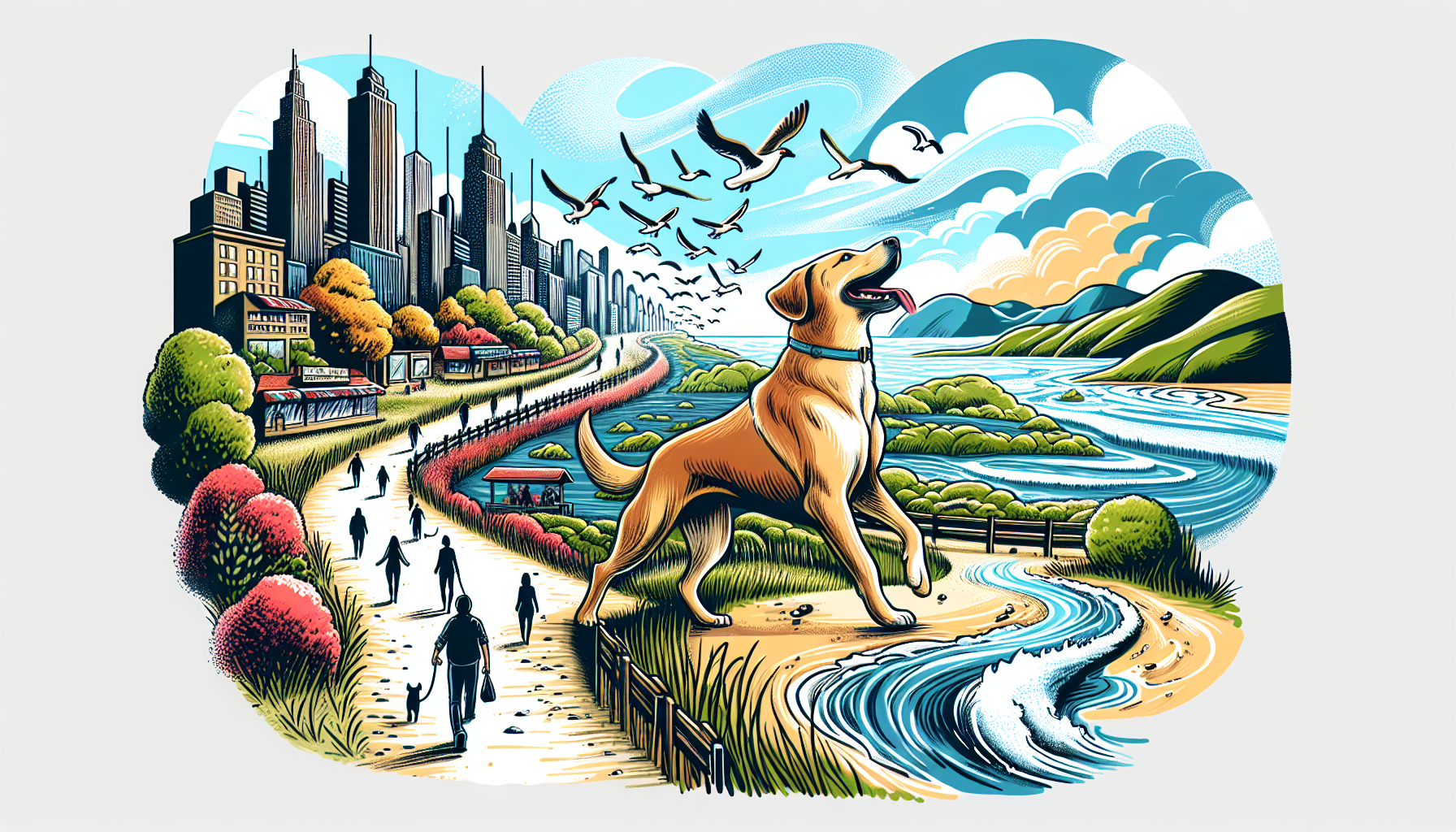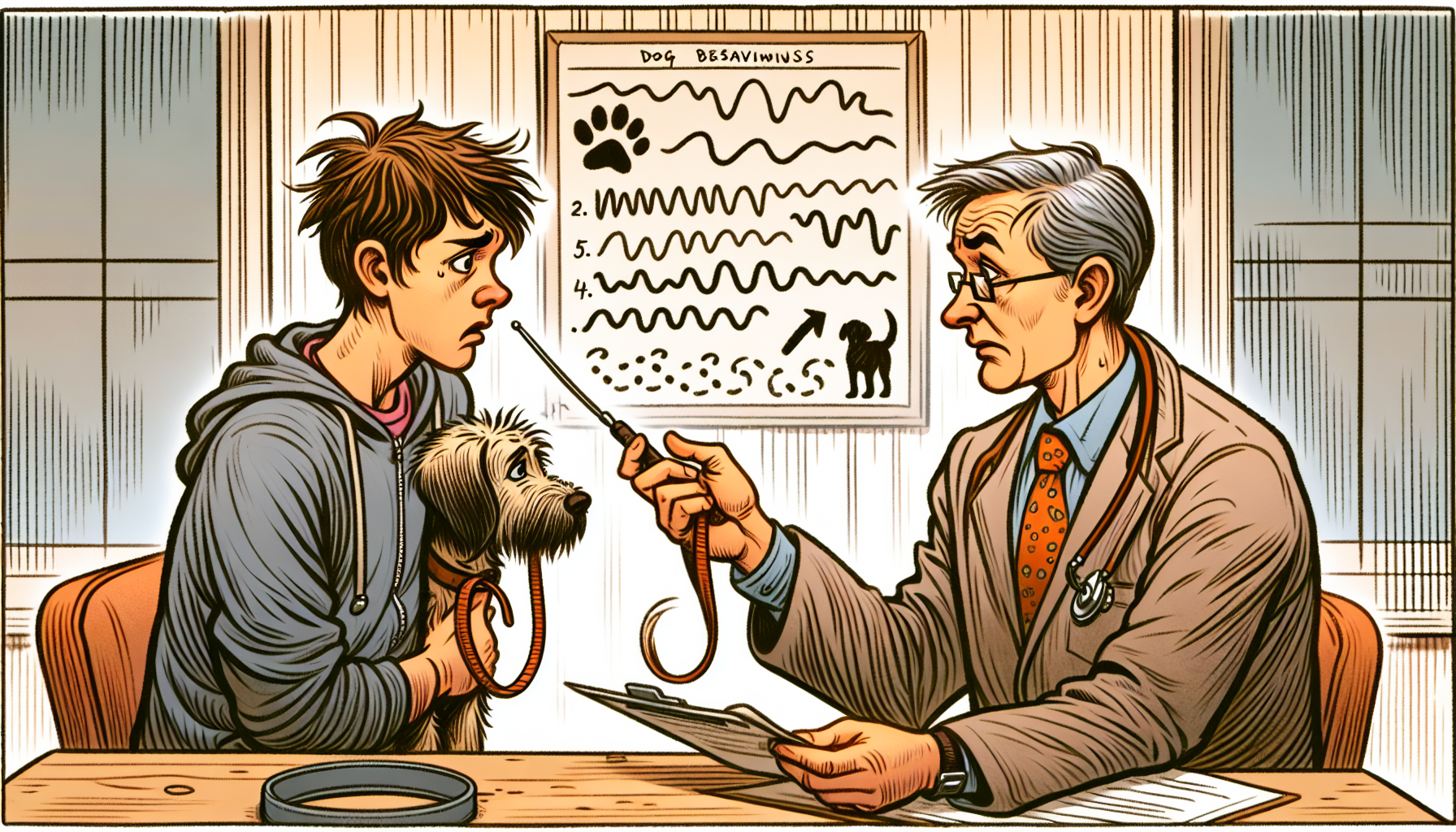Is your dog displaying an unexpected behavior where your dog lays down and refuses to move on walks and refusing to budge? It could be due to discomfort, anxiety, or just simple ennui. In this guide, we’ll explore the reasons behind this behavior and offer you strategies to effectively address and prevent it, ensuring peaceful and enjoyable walks for you and your canine companion.
Key Takeaways
- Your dog might stop and lay down during walks due to physical discomfort, anxiety, or simply boredom. Conditions like arthritis, environmental stressors, or predictable routes can prompt this behavior.
- To get your dog moving again, try using positive reinforcement with treats and praise, changing the walking route for variety, and gradually increasing walk distances. If needed, gently encourage movement without forcing the dog.
- Professional help from a vet or a dog trainer may be necessary if health issues are suspected or if the behavior persists despite efforts to address it through various strategies.
Identifying the Causes: Why Your Dog Lays Down and Refuses to Move

Understanding your dog’s behavior is the first step in addressing any issue. Dogs communicate in many ways, and sometimes, their actions speak louder than barks. So, why does your dog suddenly stop and refuse to continue the walk that dogs typically love?
One possibility is that your pooch may be experiencing physical discomfort or illness. Dogs with joint pain from conditions like arthritis or hip dysplasia may lay down and refuse to move, especially during walks. If they have sore paws or are recovering from a recent surgery, they might also exhibit this behavior. Besides, underlying health issues such as heart disease or respiratory problems could cause lethargy, leading them to lay down during outings.
The cause could also be psychological. Fear or anxiety can make dogs act out of character, displaying changes in their dog’s behavior. Stressors like:
- seeing other dogs
- people
- vehicles
- wildlife
can trigger an anxious response, causing your dog to lay down and refuse to move. Moreover, dogs are creatures of habit, and a change of routine or environment can lead to stress, prompting them to lay down.
Another cause might be simpler than you think. Could it be that your dog is simply bored? Dogs love exploring new sights, smells, and sounds. If your daily walks have become predictable, your furry friend might just be looking for some excitement. But don’t worry, there are plenty of ways to turn those dull walks into exciting adventures!
Physical Discomfort or Illness
When we feel a twinge of pain, we can voice it out or take appropriate action. But dogs aren’t so lucky. They communicate their discomfort in ways we might not always understand immediately. Conditions like hip dysplasia and arthritis, common sources of joint pain, may cause your dog to lay down during walks, especially if they’re in their senior years. If your dog stops walking and lays down, it could be due to an injury, ranging from a minor hurt nail to a severe injury or foreign object in a limb.
It’s essential to keep a keen eye on your dog’s behavior. If they exhibit signs of discomfort or reluctance to move during walks, it’s time to consult a veterinarian. This could be indicative of health issues that need to be addressed promptly. After all, our four-legged friends rely on us to keep them in the pink of health!
Fear or Anxiety
Every dog has its day, and on some days, they might not be feeling their best. Just like humans, dogs can have bouts of fear or anxiety that can make them lay down and refuse to move. Common triggers could include:
- seeing other dogs
- people
- vehicles
- wildlife
Your dog might view these as threats, causing stress. This is why understanding your dog’s fear responses and working to alleviate them is so important.
Forcing a dog to face stressors constantly can worsen the situation. It’s like asking someone afraid of heights to go skydiving – it’s bound to make things worse, not better. Similarly, if your dog’s refusal to walk is triggered by fear or anxiety due to an unfamiliar environment or past traumas, it’s crucial to recognize this and act accordingly.
Boredom or Lack of Stimulation
Imagine doing the same thing every day, with no variation – sounds dull, right? Well, your dog might feel the same way about their walks. If your dog is laying down and refusing to move, it might be a sign that they’re bored with the same route. Introducing new scents and scenery by changing the walking route can enhance the walking experience for dogs, as they thrive on novelty.
Think of it as a sensory adventure. Occasionally letting your dog choose the path during walks can maintain their interest and break the monotony. Throw in some excitement by altering the pace too. A sudden sprint or a slow amble can add variety to the walk and keep your dog engaged.
Addressing the Issue: Tips for Encouraging Your Dog to Keep Moving

Now that we’ve understood the possible reasons behind your dog’s sit-down protest, let’s explore some ways to encourage them to keep moving. Remember, dogs are highly perceptive creatures who tend to mirror their owner’s behavior. So, maintaining a calm and patient demeanor is vital when dealing with a dog’s refusal to walk. Instead of pulling on the lead, walk calmly in the direction you wish to go, patiently encouraging the dog’s movement with praise. Some other strategies you can try include:
- Using treats or toys as incentives to get your dog to walk
- Changing up your walking route to make it more interesting for your dog
- Gradually increasing the distance and duration of your walks
- Seeking professional help from a dog trainer or behaviorist if the issue persists
By implementing these strategies and staying consistent, you can help your dog overcome their reluctance to walk and enjoy their daily exercise.
Another effective strategy is to gently prompt a stationary dog to start moving. By applying light pressure to the side, causing a slight imbalance, you can encourage the dog to step forward. But remember, every dog is unique, so it’s important to find the approach that works best for your furry friend.
Positive Reinforcement and Treats
Dogs, like people, respond well to encouragement and rewards. This is where positive reinforcement comes into play. By using small, bite-sized treats during walks, you can effectively revive a dog’s enthusiasm, particularly for those that are food motivated. Remember, rewards can be more than just food. Dogs love praise, toys, and affection too, so mix it up and see what your dog responds to best.
Positive reinforcement is about rewarding your dog for a job well done, encouraging them to repeat actions that result in positive outcomes such as receiving treats, praise, or playtime. In other words, if your dog continues to walk without laying down, they receive a reward. This not only motivates them to keep moving but also provides them with a sense of control, increasing the likelihood of cooperation and continued movement.
Varying the Route and Pace

We’ve talked about the importance of stimulating your dog’s senses, and varying the route and pace of your walks is a great way to do this. By altering the walking route, you can help reduce anxiety in your dog by avoiding known stressors that might cause them to halt and lay down. Plus, regularly changing your dog’s walking routine can prevent boredom and stimulate their interest, making them less likely to stop moving.
In addition, when dogs are introduced to each other during walks, varying the pace can help reduce pressure and allow them to comfortably interact without feeling the need to lay down and stop the walk. Think of it as a socializing walk – a chance for your dog to meet new friends and enjoy the experience.
Building Confidence Through Training
Training is more than just teaching your dog to sit, stay, or fetch. It’s about building confidence and trust. Desensitization and counterconditioning are effective training methods that can help dogs overcome their fears and become more confident. By gradually exposing your dog to the things they fear in a controlled and positive way, you can help them overcome their anxieties.
Allowing dogs to make choices during training sessions, such as which treats to have or whether to engage in the training, enhances their confidence and trust. Remember, a dog’s refusal to walk could be due to a variety of reasons, not solely a lack of training. Understanding these is crucial to addressing their individual needs.
The Role of Socialization in Preventing Stubborn Behavior

Socialization plays a critical role in shaping a dog’s behavior. It teaches dogs to interact confidently with their environment, reducing the chances of fearful reactions during walks. Socializing dogs with their peers in group settings helps them develop social skills and gain confidence, which in turn, reduces stubborn behavior during walks.
Building a routine and consistent approach to positive reinforcement can help dogs understand what is expected of them, fostering a stronger bond between the dog and its owner. Some ways to establish a routine of positive reinforcement include:
- Using treats or praise to reward desired behaviors
- Consistently using the same commands and cues
- Setting aside dedicated training time each day
- Providing regular opportunities for socialization with other dogs and people
By implementing these strategies, owners can help address stubborn behaviors and build a stronger relationship with their dogs.
Introducing Your Dog to New Experiences
Exposing dogs to new experiences is an essential part of socialization. Whether it’s a new toy, a different trail in the park, or a visit to a friend’s house, these new experiences can greatly help build your dog’s confidence. These controlled positive exposures can make your dog less fearful and more adaptable to new situations.
Transporting dogs to different locations such as parks or new neighborhoods provides exciting environments that enhance their cognitive abilities. Varied environments and activities help dogs to become more adaptable and less likely to exhibit stubborn behavior during walks. Not to mention, shared experiences with other dogs can help them become more comfortable and enhance their social adaptability.
Organizing Playdates and Group Walks
Organizing playdates and group walks can turn walks into a fun, social event that your dog will start to look forward to. Not only does this provide your pooch with a chance to interact with their canine friends, but it also adds an element of excitement to their routine. Hiring a dog walker for these group walks can ensure your pet gets the socialization they need.
Plus, it gives you, the owner, a chance to share tips and experiences with other dog owners and dog lovers in our forum community dedicated to all things dog-related!
When to Seek Professional Help: Consulting a Veterinarian or Trainer

While the tips and strategies discussed above can certainly help, there are times when professional help may be needed. If your adult dog consistently lays down and refuses to move during walks, it could indicate underlying issues requiring evaluation by a veterinarian or professional dog trainer.
It’s always better to seek help early rather than waiting until you’ve finally figured out that the treat thing behavior persists and escalates.
Assessing Your Dog’s Health
Regular veterinary visits are crucial to check for underlying health issues that may cause a dog to lay down during walks. Some common health issues that might cause a dog to lay down during walks include:
- Muscle diseases
- Joint and limb dysfunctions
- Tumors
- Infections
If identified early, many of these conditions can be treated with medications, surgery, or other therapies like chemotherapy and radiation.
In some cases, conditions like intervertebral disc disease and degenerative myelopathy may require:
- Pain relief
- Anti-inflammatory medication
- Supportive care
- Mobility aids
when surgery is not an option or no treatment is available. So, it’s crucial to keep an eye on any changes in your dog’s behavior and seek veterinary advice when needed.
Working with a Trainer or Behaviorist
In some cases, you might need the help of a professional dog trainer or behaviorist. These experts can develop customized strategies tailored to your dog’s specific issues, leading to more effective and quicker behavioral improvements. Hiring a professional dog trainer offers benefits such as:
- Personalized training approaches
- More rapid learning in an environment without distractions
- Enhanced results when the dog owner actively participates by doing assigned homework between sessions.
Remember, every young dog is unique, and the approach that works for one might not work for another, especially when dealing with young dogs and young puppies.
Summary
In conclusion, understanding why your dog lays down and refuses to move during walks is the first step to addressing the issue. Whether it’s due to physical discomfort, fear, or boredom, identifying the cause can help you tailor your approach. Remember, patience, understanding, and positive reinforcement go a long way in encouraging your dog to keep moving. If your dog’s behavior persists despite your best efforts, don’t hesitate to seek professional help. After all, our furry friends deserve the best care we can provide!
Frequently Asked Questions
Why does my dog sit down and refuse to move?
Your dog might be sitting down and refusing to move due to various reasons, such as being distracted, uninterested, afraid, or experiencing discomfort due to a health issue. If this behavior continues, it’s best to consult with a veterinarian to rule out any underlying health issues.
What to do when your dog doesn’t want to move?
If your dog refuses to move, it’s best to call your vet for advice and book a physical examination as soon as possible, as it could be due to an underlying medical condition.
How can socialization help in preventing stubborn behavior?
Socializing your dog can help them feel more confident and less likely to exhibit stubborn behavior during walks. It’s a great way to prevent fearful or stubborn reactions.
When should I seek professional help for my dog’s behavior during walks?
You should seek professional help if your dog consistently lays down and refuses to move during walks, as it could indicate underlying issues that require evaluation by a veterinarian or dog trainer.
How can I assess my dog’s health related to their behavior during walks?
Take your dog to the vet for regular check-ups to identify any health issues causing changes in their behavior during walks.